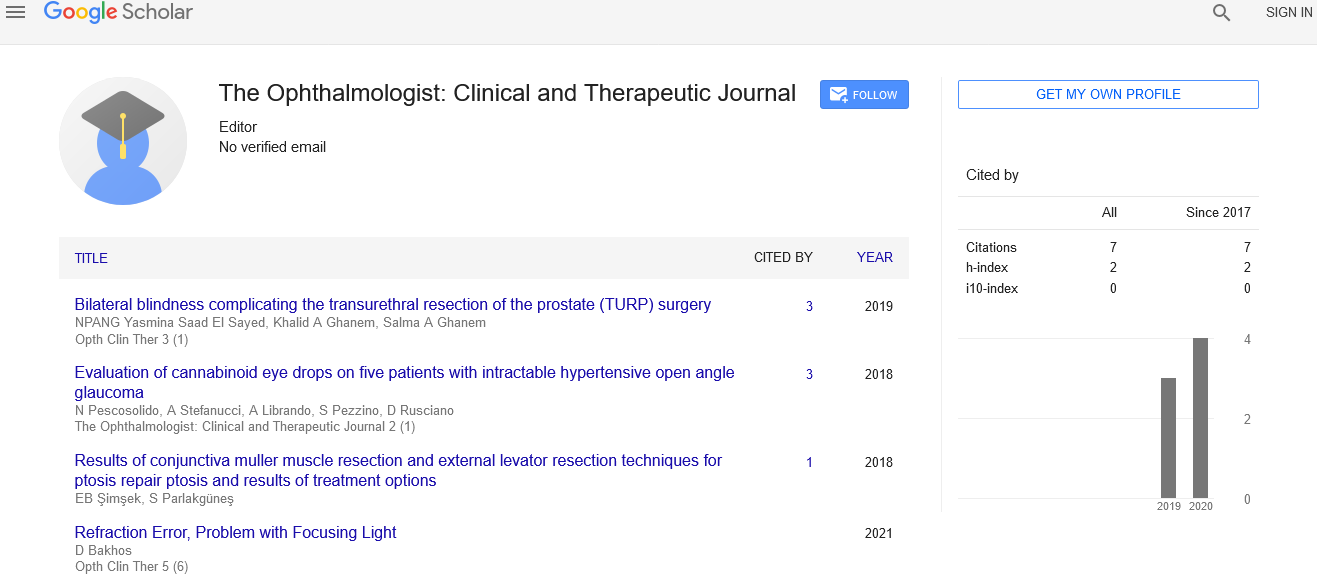A synopsis on previous issue
Received: 04-Jan-2021 Accepted Date: Jan 18, 2021; Published: 25-Jan-2021
Citation: Xu L. A synopsis on previous issue. Opth Clin Ther. 2021;5(1):3.
This open-access article is distributed under the terms of the Creative Commons Attribution Non-Commercial License (CC BY-NC) (http://creativecommons.org/licenses/by-nc/4.0/), which permits reuse, distribution and reproduction of the article, provided that the original work is properly cited and the reuse is restricted to noncommercial purposes. For commercial reuse, contact reprints@pulsus.com
Abstract
In the interests of Journal of our Journal, writers editors and my Co- Editors, I am pleased to present the volume 4, issue 3 of the journal. The journal established in 2017 has now published 7 issues. We could reach this position through the continuous support of board members and intellectual amplitude of our readers and contributors (authors and reviewers).
Description
In the interests of Journal of our Journal, writers editors and my Co- Editors, I am pleased to present the volume 4, issue 3 of the journal. The journal established in 2017 has now published 7 issues. We could reach this position through the continuous support of board members and intellectual amplitude of our readers and contributors (authors and reviewers).
The Ophthalmologist: Clinical and Therapeutic Journal is an open access, peer – reviewed, academic journal which has a wide range of fields which creates a platform for the authors to publish a relatively reliable source of information on recent technology, review articles, original articles etc. and provides free online access to the researchers worldwide.
The research article entitled “Comparison between the real corneal ablation excimer laser and the theoretical munnerlyns formula and the residual corneal thickness after lasik compared to safety limits” by Pateras Evangelos and Kontogeorgou Evangelos xplained about the difference between the real corneal ablation (excimer Laser) with the theoretical (Munnerlyn’s Formula) and the residual corneal thickness after lasik compared to safety limits. The sample design and study was done by comparing the data collected from 35pairs of eyes from patients’ age starting from 19 years to 59 years who have gone the Lasik surgery for Myopia condition. The results that are obtained from the ablation thickness with excimer laser lasik refractive surgery were compared between the theoretical Munnerlyn’s formulas.
The short communication entitled “Treatment of vogt koyanagi harada disease” by Akinfe AA, et al. described about the Vogt-Koyanagi-Harada (VKH) disease. It was mentioned that the disease is an auto immune disorder which was T-cell mediated and was characterized by granulomatous pan uveitis with a variety of other systemic manifestations. The disease is usually accompanied by the symptoms like red eyes, blurred vision, and pain. An antigenic component present in dermal, uveal, and meningeal melanocytes seems to be directing an autoimmune reaction. VKH disease, the combined therapy of immunosuppressive drugs with steroids was effective in improving our patient’s visual impairment.
The case report entitled “Optical scleral contact lens in a patient with tectonic corneal graft” by Harish Bhardwaj explained about the Scleral contact lens for a patient with tectonic corneal graft. The article is about the patient who was unable get vision with normal spectacles or contact lens, but the vision can be gained by corneal grafts that were places in both the eyes of the patients. Atlantis scleral contact lens fitting was done to the left eye (Boston, XO materials).
The editorial entitled “Prevalence of glaucoma” by Denise Klett summarised about the glaucoma and its effect on vision. The articles describes about the symptoms, causes, risk factors, occurrence and prevention for the glaucoma.
The editorial entitled “Therapeutic progression of ophthalmology” by David Morrison, explained about the developments in the therapeutic fields of ophthalmology. The author described about the various diseases and treatment options for vision impairment and vision loss. The article also mentions about the various condition that may lead to the eye disorders.
Conclusion
I thank all reviewers for their excellent contributions. At this stage we are calling for submissions of articles, commentaries, and letters to the editor for the upcoming issues. We glance forward to receiving your exciting contribution. Finally, I would like to thank you, the contributors and readers for your interest in the journal and I encourage you to continue to send us your valuable feedback and ideas for further improvement of our journal.





